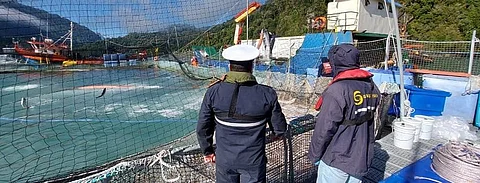

Chile's National Fisheries and Aquaculture Service (Sernapesca) said that thirteen salmon farms in the Reloncavi estuary area, Los Lagos region, reported the activation of the harmful algal bloom (HAB) contingency plan due to the presence of the microalgae Thalassiosira pseudonana "at levels considered harmful to fish." Subsequently, seven of these farms also activated their contingency plan for massive mortality associated with the presence of microalgae. However, after analyzing all the information, Sernapesca determined that only two of them were actually in this condition.
"From Sernapesca, we are monitoring and inspecting in person, remotely and documenting compliance with the contingency action plans of each affected farming center, in coordination with the institutions that make up the regional CIICA," said Cristian Hudson, Regional Director of Sernapesca Los Lagos.
"Up to the minute, the situation is being addressed normally through the capabilities available to the holders of the affected facilities to deal with this type of event. For our part, we will maintain vigilance until the contingency is closed," he added.
Last week Sernapesca had already published an aquaculture pre-alert establishing exceptional measures for possible events of mass mortalities of salmonids generated by harmful algal blooms.
At the time of writing this article, Chile's National Fisheries and Aquaculture Service had not provided the possible number of fish affected by this mass mortality event, nor which salmon-producing companies are affected.
However, Sernapesca hastened to indicate that this algal bloom does not correspond to the red tide (so-called because it is a concentration of unicellular algae producing a reddish color on the sea surface). These microorganisms produce toxins that accumulate in the bodies of mollusks and crustaceans and make their consumption dangerous, although the Chilean authority has confirmed that, on this occasion, "there is no effect on bivalve mollusks or other fish."
Dr. Leonardo Guzmán, an expert in algal blooms at the Chilean Fisheries Development Institute (IFOP) explained that "in spring there are ideal conditions of light and nutrients, which favors the increase of these microalgae," although he also clarified that "the available information does not allow linking this bloom with the El Niño event that is currently affecting the north of our country."
Nevertheless, the Center for the Study of Harmful Algae (CREAN) of IFOP will continue to monitor, as it has been doing since 2006, the entire inland sea of the Los Lagos region, and even the regions of Aysén and Magallanes, further south and therefore with less theoretical risk of being affected by El Niño.
This global climate phenomenon, which has put other industries such as the shrimp industry in Ecuador on alert, is also a constant concern for Chile, which is why the South American country has been preparing for months, coordinating the public and private sectors to face its possible effects, which are expected to intensify in spring months, the current season in the austral zone.
